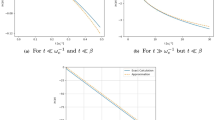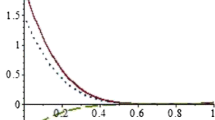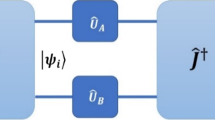Abstract
The Eisert–Wilkens–Lewenstein (EWL) game can be used to solve the quantum prisoner’s dilemma is investigated. It is assumed that the states of the players are polarized in different directions, and the entangling gate is time dependent, with interaction strength represented by linear, sine, cosine, or exponential functions. If both players cooperate, the payoffs remain above their classical counterparts. However, if they do not cooperate, the payoff for one player increases at the expense of the other. The payoffs of both players are similar when their states are prepared with the same settings, whereas different settings for the initial states result in different payoffs. Due to the periodic nature of the interaction strength, the payoffs oscillate between their classical bounds when both initial states have the same settings. Conversely, for different initial state, the upper bounds are lower than the classical ones, while the minimum values remain above their corresponding classical payoffs.












Similar content being viewed by others
Explore related subjects
Discover the latest articles, news and stories from top researchers in related subjects.Data availability
The used code of this study is available from the corresponding author upon reasonable request.
References
Alonso-Sanz, R.: Quantum Game Simulation, vol. 36. Springer, New York (2019)
David, A.M.: Quantum strategies. Phys. Rev. Lett. 82, 1052–1055 (1999)
Eisert, J., Wilkens, M., Lewenstein, M.: Quantum games and quantum strategies. Phys. Rev. Lett. 83, 3077–3080 (1999)
Consuelo-Leal, A., Araujo-Ferreira, A.G., Lucas-Oliveira, E., Bonagamba, T.J., Auccaise, R.: Pareto-optimal solution for the quantum battle of the sexes. Quantum Inf. Process. 19, 1–21 (2020)
Szopa, M.: Efficiency of classical and quantum games equilibria. Entropy 23(5), 506 (2021)
Piotrowski, E.W., Sładkowski, J.: Quantum bargaining games. Physica A 308(1–4), 391–401 (2002)
Chen, K.-Y., Hogg, T.: How well do people play a quantum prisoner’s dilemma? Quantum Inf. Process. 5, 43–67 (2006)
Piotrowski, E.W.: Quantum auctions: facts and myths. Phys. A 387(15), 3949–3953 (2008)
Ramzan, M., Khan, M.K.: Environment-assisted quantum minority games. Fluct. Noise Lett. 12(04), 1350025 (2013)
Ikeda, K., Aoki, S.: Theory of quantum games and quantum economic behavior. Quantum Inf. Process. 21(1), 27 (2022)
Ning Bao and Nicole Yunger Halpern: Quantum voting and violation of Arrow’s impossibility theorem. Phys. Rev. A 95(6), 062306 (2017)
Huang, D., Li, S.: Analysis of the quantum evolutionary game of coordination game. Chin. J. Man. Sci. 31(6), 253–264 (2023)
Nguyen, P.-N.: The duality game: a quantum algorithm for body dynamics modeling. Quantum Inf. Process. 23(1), 21 (2024)
Gao, M., Ji, Z., Li, T., Wang, Q.: Logarithmic-regret quantum learning algorithms for zero-sum games. Adv. Neur. Inf. 36, (2024)
Jiangfeng, D., Li, H., Xiaodong, X., Shi, M., Jihui, W., Zhou, X., Han, R.: Experimental realization of quantum games on a quantum computer. Phys. Rev. Lett. 88(13), 137902 (2002)
Mitra, A., Sivapriya, K., Kumar, A.: Experimental implementation of a three qubit quantum game with corrupt source using nuclear magnetic resonance quantum information processor. J. Magn. Reson. 187(2), 306–313 (2007)
Ulibarrena, A., Sopena, A., Brooks, R., Centeno, D., Ho, J., Sierra, G., Fedrizzi, A.: Photonic implementation of the quantum Morra game. Phys. Rev. Res. 6, 023248 (2024)
Solmeyer, N., Linke, N.M., Figgatt, C., Landsman, K.A., Balu, R., Siopsis, G., Monroe, C.: Demonstration of a Bayesian quantum game on an ion-trap quantum computer. Quantum Sci. Technol. 3(4), 045002 (2018)
Song, Q., Weiping, F., Wang, W., Sun, Y., Wang, D., Zhou, J.: Quantum decision making in automatic driving. Sci. Rep. 12(1), 11042 (2022)
Elgazzar, A.S.: Coopetition in quantum prisoner’s dilemma and COVID-19. Quantum Inf. Process. 20(3), 102 (2021)
Prafulla Kumar Padhi and Feranando Charrua-Santos: Quantum biotech and internet of virus things: towards a theoretical framework. Appl. Syst. Inn. 4(2), 27 (2021)
Khan, S., Khalid, K.M.: Noisy relativistic quantum games in noninertial frames. Quantum Inf. Process. 12, 1351–1363 (2013)
Clausen, J., Briegel, H.J.: Quantum machine learning with glow for episodic tasks and decision games. Phys. Rev. A 97, 022303 (2018)
Abd El-Hakeem EH Abd El-Naby, Elrayes, H.A., Tarabia, A.M.K., Elgazzar, A.S.: Arbitrary maximally entangled quantum prisoner’s dilemma. Z. fur Naturforsch. A, 79(2), 133–140 (2024)
Altintas, A.A., Ozaydin, F., Bayindir, C., Bayrakci, V.: Prisoners’ dilemma in a spatially separated system based on spin-photon interactions. Photonics 9(9), 617 (2022)
Bugu, S., Ozaydin, F., Kodera, T.: Surpassing the classical limit in magic square game with distant quantum dots coupled to optical cavities. Sci. Rep. 10(1), 22202 (2020)
Ozaydin, F.: Quantum pseudo-telepathy in spin systems: the magic square game under magnetic fields and the Dzyaloshinskii-Moriya interaction. Laser Phys. 30(2), 025203 (2020)
Elgazzar, A.S.: Unique solution to the quantum prisoner’s dilemma game. J. Phys. Soc. Jpn. 88(3), 034801 (2019)
He, D., Ye, T.: An improvement of quantum Prisoners’ Dilemma protocol of Eisert–Wilkens–Lewenstein. Int. J. Theor. Phys. 59, 1382–1395 (2020)
Kameshwari, A.V.S., Balakrishnan, S.: Study of decoherence and memory in modified Eisert–Wilkens–Lewenstein scheme. Quantum Inf. Process. 20, 1–20 (2021)
Huang, Z., Qiu, D.: Quantum games under decoherence. Int. J. Theor. Phys. 55, 965–992 (2016)
Tomamichel, M., Fehr, S., Kaniewski, J., Wehner, S.: A monogamy-of-entanglement game with applications to device-independent quantum cryptography. New J. Phys. 15(10), 103002 (2013)
Piotrowski, E.W., Sładkowski, J.: Quantum market games. Phys. A 1–2, 208–216 (2002)
Flitney, A.P., Abbott, D.: Advantage of a quantum player over a classical one in 2\(\times \) 2 quantum games. Proc. R. Soc. Lond. A 459(2038), 2463–2474 (2003)
Acknowledgements
We would like to thank the referees for their reports which help us to modify our manuscript. This work was supported in part by the University of Chinese Academy of Sciences.
Author information
Authors and Affiliations
Contributions
ATM prepared all figures and wrote the original draft. MYA-R performed the mathematical calculations. NM reviewed the draft. All authors read and agreed to the published version of the manuscript.
Corresponding author
Ethics declarations
Ethical approval
The authors declare that there is no conflict with publication ethics.
Conflict of interest
There is no conflict of interest regarding the publication of this paper.
Additional information
Publisher's Note
Springer Nature remains neutral with regard to jurisdictional claims in published maps and institutional affiliations.
Appendix
Appendix
In this appendix, we show the elements of the final state are defined by a \(4\times 4 \) matrix, if the states of the player, Alice and Bob, are defined as \(\bigl | \psi _A(0) \bigr \rangle =\bigl | 0 \bigr \rangle _A\), \(\bigl | \psi _B(0) \bigr \rangle =\bigl | 0 \bigr \rangle _B\), respectively. Then the total initial state of the players is given by (6). If players apply their strategies and send their pairs to the entangling gate, then the players follow the steps described in Sect. 2. Finally, the final state is defined by
Rights and permissions
Springer Nature or its licensor (e.g. a society or other partner) holds exclusive rights to this article under a publishing agreement with the author(s) or other rightsholder(s); author self-archiving of the accepted manuscript version of this article is solely governed by the terms of such publishing agreement and applicable law.
About this article
Cite this article
Makram-Allah, A.T.M., Abd-Rabbou, M.Y. & Metwally, N. Time dependence of Eisert–Wilkens–Lewenstein quantum game. Quantum Inf Process 23, 393 (2024). https://doi.org/10.1007/s11128-024-04589-2
Received:
Accepted:
Published:
DOI: https://doi.org/10.1007/s11128-024-04589-2




